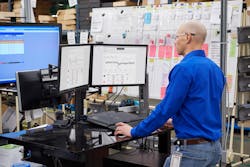Why condition monitoring is your gateway to Industry 4.0
Since the goals of Industry 4.0 began circulating in 2010, process manufacturing has worked to leverage its intensive automation knowledge into a new state of next-level connected efficiency. Are we there yet? No, but we are making headway.
Some processing plants (especially greenfield) have made remarkable progress toward connected systems, data and teams. And most greenfield sites today begin planning linked systems before the assets are ever installed. On the other hand, legacy sites are bound to infrastructure that often supports a different reality from which they were designed. And to complicate that, they can struggle to overcome proprietary silos, organizational silos and embedded ways of working.
For all those processing plants that must continuously retool what they have, I will argue that a good foundation in condition monitoring is the best way for process manufacturing operations to achieve the efficiency goals promised by Industry 4.0.
The promise of Industry 4.0
Plant leaders know there are megatrends underway that promise to deliver ROI — and for operations, this revolution is all about connecting asset health insights based on real-time condition data to maintenance teams and their systems of record.
Logistics and supply chain management were early adopters of the Industry 4.0 approach and have proven the benefits. It is now time for other areas of the plant to adopt the mindset. "Smart factory" or Industry 4.0 environments connect systems to build an "intelligent network" of machines and processes, treating every facet of the operation as a potential profit center. Envision a digital layer overtop mechanical and human operations that is constantly monitoring, interpreting, reporting on and, in some cases, directing the actions of the physical machine layer.
Yes, SCADA already does some of this, as do individual OEM machines and many other closed-loop systems. Industry 4.0 challenges us to view those systems in terms of their operational data value and to convert them from individual systems to an overall connected framework that reaches beyond the manufacturing execution system (MES) and into enterprise asset management (EAM).
What data do we need to build a real-time digital picture of plant health? Where would that data come from? What would we need to do with it to make it actionable?
For operations, the goal is to radically improve visibility to machine health — with enough data history and AI computing power to generate predictive and prescriptive insights.
Every company we talk to recognizes that working toward predictive maintenance is a worthy goal because it can step-change what operations contributes to the business. When I began my career, 80/20 was considered ideal — 80% planned, calendar-driven PMs, and 20% on-the-fly corrective maintenance. But we MRO folks are always looking for opportunities to improve: Yesterday's best practices won't carry us into tomorrow.
Over time, we have realized calendar PMs can introduce risk. Was that bolt tightened? Were the consumable parts properly sourced? Was lubrication done perfectly? What's more, under event and calendar-based approaches, maintenance dollars are often overspent in some areas and underspent in others. More organizations now favor an asset-centric approach where maintenance dollars are spent on what the assets themselves are telling us to do.
Industry 4.0 technology and processes work toward minimizing unplanned maintenance emergencies and leveraging the efficiency of condition-based, just-in-time inventory, labor and repairs.
Why condition monitoring is the foundation of Industry 4.0
Condition monitoring — successfully deployed — is the essential gateway to Industry 4.0 and realizing new business value.
Every Industry 4.0 application out there presumes data connectivity. But that data — and its connectivity — can be the most challenging part to get right. Data availability sets the limits for what analytics can deliver. Put another way, analytics solutions are only as sophisticated as their data back end can support.
Achieving the benefits of predictive maintenance via an Industry 4.0-style plant requires a sufficient data capture ecosystem capable of "listening" to the plant's most critical assets and getting that meaningful data where it needs to be.
Automating data capture is also often the most realistic way for an operations team to move forward. Many teams report:
- Too many assets to service
- Shortage of asset reliability expertise
- Not enough time
- A shift from SMEs to "everyone does everything"
Condition monitoring addresses all of these challenges. Operations teams usually benefit most from an asset-centric data approach where data is specifically captured and organized to deliver asset health insights. Condition monitoring, either by wired or wireless sensors, should capture vibration, temperature and power signatures for the 20% most critical plant assets.
Many processing plants prioritize their condition monitoring deployment on equipment that is too hazardous for standard inspection procedures but too critical to fail unexpectedly. Examples include pumps in difficult-to-reach areas subject to dangerous temperatures, overhead fans lodged in ductwork and belt-drive fans with guards preventing access to the bearings. Installing condition monitoring on those systems improves health and safety conditions and provides quantifiable data on the risk of damage and, ultimately, preventing downtime.
Connecting the systems
Once the most beneficial types of asset data have been identified for condition monitoring, the system needs to funnel that data into a platform where it can be aggregated and integrated with data from other operational systems for comparison against machine failure indications.
That is because, on its own, condition monitoring data is incomplete. It does not know when an asset was last serviced or what actions were performed, or when maintenance is next due. It does not see the asset's history of failure, what parts are needed to complete specific jobs, and whether those parts are on hand.
But without condition monitoring, the engineer is operating blind. The more we can see in advance, the more we can prepare to avoid machine failure.
Continuous monitoring must be combined with carefully curated asset history and failure data, and specific runtime data streams, creating an asset health foundation able to support condition-based maintenance. Technicians are notified when an asset changes condition, and work is prioritized based on real-time asset health.
Successfully deploying condition monitoring requires a systematic approach befitting the roots of process manufacturing and dedication to system integration worthy of Industry 4.0. The full scope of a connected operations ecosystem should include:
- Data connectivity: All types and sources of data are combined into a usable location and state.
- System connectivity: Integration of asset health data with related systems used by operations, maintenance and reliability.
- Teams connectivity: All personnel have access to asset information, which allows for more efficient maintenance actions.
Creating a roadmap to Industry 4.0
Many operations start with condition monitoring and have it become their baseline for continuous progress toward connected systems. If you face legacy issues, integration hurdles and budget restraints, follow the classic pilot model — focus on feasible projects that tackle urgent needs with visible benefits. Be experimental and selective and try to avoid preconceived notions of what will and will not work.
Here are three key principles for making progress:
1. Focus on value drivers
- Think value-backward, not technology forward, and focus on industry-specific key value drivers.
- Develop a compelling vision and inspire the organization through lighthouse pilots.
2. Mobilize the organization
- Drive the transformation from the top with clear business ownership.
- Lock in bottom-line benefits quickly to prove the value early.
- Build capabilities and cultivate a highly agile culture.
- Build a cross-functional team representing different departments and silos.
3. Innovate the infrastructure
- Define an integrated target technology stack based on a thorough analysis of the status quo.
- Choose a transition pathway and enable it locally before scaling globally.
Start with a small group and ensure everyone is trained not just on condition monitoring but also on the core aspects of Industry 4.0. A beginner's understanding of AI and machine learning will go a long way toward creating support for connected systems' larger goal. Study the difference between descriptive, predictive and prescriptive analytics.
Also, set measurable project targets that slightly exceed what existing processes can accomplish, demonstrating the promise and making it easy to communicate progress. Lastly, senior management must be involved — as drivers, funders and challengers. Executives need to do more than ask for "something IoT." They need to support the project fully.
Everything around condition monitoring points to endless opportunity. The technologies are coming together: sensors, networks and processing power are improving as prices are decreasing.
Teams can now feasibly expand their condition monitoring program beyond their top 20% assets to the next tier of operations, leveraging their initial investment into far greater returns. Before you know it, we will be talking plant-wide condition monitoring, supporting an even greater level of connectivity. And Industry 4.0 will be even further along.
Brian Harrison is the Fluke Reliability industry lead for IIoT. He is a certified reliability leader with more than 10 years in enterprise asset management.



